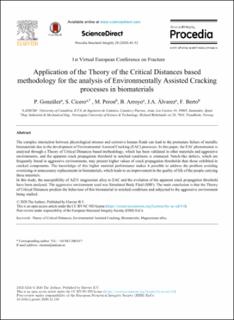| dc.contributor.author | González, Pablo | |
| dc.contributor.author | Cicero, Sergio | |
| dc.contributor.author | Peron, Mirco | |
| dc.contributor.author | Arroyo, Borja | |
| dc.contributor.author | Alvarez, Jose Alberto | |
| dc.contributor.author | Berto, Filippo | |
| dc.date.accessioned | 2021-04-23T11:45:46Z | |
| dc.date.available | 2021-04-23T11:45:46Z | |
| dc.date.created | 2020-12-17T10:16:20Z | |
| dc.date.issued | 2020 | |
| dc.identifier.citation | Procedia Structural Integrity. 2020, 28, 45-52. | en_US |
| dc.identifier.issn | 2452-3216 | |
| dc.identifier.uri | https://hdl.handle.net/11250/2739345 | |
| dc.description.abstract | The complex interaction between physiological stresses and corrosive human fluids can lead to the premature failure of metallic biomaterials due to the development of Environmental Assisted Cracking (EAC) processes. In this paper, the EAC phenomenon is analysed through a Theory of Critical Distances based methodology, which has been validated in other materials and aggressive environments, and the apparent crack propagation threshold in notched conditions is estimated. Notch-like defects, which are frequently found in aggressive environments, may present higher values of crack propagation thresholds than those exhibited in cracked components. The knowledge of this higher material performance makes it possible to address the problem avoiding oversizing or unnecessary replacements in biomaterials, which leads to an improvement in the quality of life of the people carrying these materials.
In this study, the susceptibility of AZ31 magnesium alloy to EAC and the evolution of the apparent crack propagation threshold have been analysed. The aggressive environment used was Simulated Body Fluid (SBF). The main conclusion is that the Theory of Critical Distances predicts the behaviour of this biomaterial in notched conditions and subjected to the aggressive environment being studied. | en_US |
| dc.language.iso | eng | en_US |
| dc.publisher | Elsevier Science | en_US |
| dc.rights | Attribution-NonCommercial-NoDerivatives 4.0 Internasjonal | * |
| dc.rights.uri | http://creativecommons.org/licenses/by-nc-nd/4.0/deed.no | * |
| dc.title | Application of the Theory of the Critical Distances based methodology for the analysis of Environmentally Assisted Cracking processes in biomaterials | en_US |
| dc.type | Peer reviewed | en_US |
| dc.type | Journal article | en_US |
| dc.description.version | publishedVersion | en_US |
| dc.source.pagenumber | 45-52 | en_US |
| dc.source.volume | 28 | en_US |
| dc.source.journal | Procedia Structural Integrity | en_US |
| dc.identifier.doi | 10.1016/j.prostr.2020.11.130 | |
| dc.identifier.cristin | 1860892 | |
| dc.description.localcode | This article is available under the Creative Commons CC-BY-NC-ND license and permits non-commercial use of the work as published, without adaptation or alteration provided the work is fully attributed. | en_US |
| cristin.ispublished | true | |
| cristin.fulltext | original | |
| cristin.qualitycode | 1 | |

